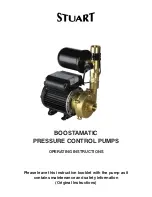
11
8.0 – OPERATION
See Figure 8.0.1 on the opposite page for a general
view of the EP.
8.1 – Initial Power-up
This procedure provides a quick check to verify the
system is wired and functioning correctly. With the
system wired completely as in Section 7.3:
1. Turn the INPUT & OUTPUT switches OFF:
•
The AC indicator should be dark.
•
The ALARM indicator should be lit.
•
The LOAD indicator should be dark.
2. Turn the OUTPUT switch ON:
•
The AC indicator should be dark.
•
The ALARM indictor should be lit.
•
The LOAD indicator should be lit
3. Turn the INPUT switch ON:
•
The AC indicator should be lit.
•
The ALARM indicator should be dark.
•
The LOAD indicator should be lit.
8.2 – Normal Operation
In normal operation, LINE-UP mode, both the AC
and LOAD indicators should be lit and the ALARM
indicator should be dark. The EP is supplying
energy to charge the battery and power the load.
The battery voltage should either be: at the
maximum charging voltage, about 13.8 Volts for a
12 Volt system, 27.6 Volts for 24 Volt system; or
rising slowly to these levels. These voltages vary
with temperature, lower at high temperatures, higher
at low temperatures.
In back-up operation, LINE-DOWN mode, the AC
indicator should be dark and both the ALARM and
LOAD indicators should be lit. The battery is
supplying the energy to the load. The battery
voltage should be falling slowly.
In either mode, you may monitor the battery voltage
to check the charging function. Generally, a rising
voltage indicates a charging battery while a falling
voltage indicates a discharging battery. If the
system has a large battery capacity, these changes
may occur too slowly to observe. If so, record the
voltage and allow several minutes or hours and
check the voltage again.
If you suspect the system is not functioning properly,
see the troubleshooting points in Section 8.3.
8.3 – Troubleshooting
The following is a list of problems you may
experience and the most likely remedy:
The INPUT switch trips and will not reset:
•
Check the incoming voltage. The voltage
across terminals L and N should less than
265 VAC or 370 VDC. Excessive input
voltage will damage the DC-UPS.
The AC indicator fails to light with the INPUT
switch ON:
•
Check the incoming voltage. The voltage
across terminals L and N should be at least
85 VAC or 110 VDC.
•
Check for a shorted battery or battery wiring.
Examine the battery wiring, if good remove
the positive connection at the battery. If the
AC indicator lights, the battery is defective.
The ALARM indicator fails to light with the INPUT
switch OFF:
•
Check the battery wiring for shorts.
•
Check the battery for proper voltage at least
11.5 Volts for a 12 Volt system and 23 Volts
for a 24 Volt system. If the battery voltage is
less than this; the battery is probably
defective or worn out.
•
Check the fuse.
The battery fails to charge while the AC indicator
is lit:
•
Check the fuse.
•
Check the battery wiring.
•
Check the battery; the battery may be
defective or worn out.
The LOAD indicator fails to light with the
OUTPUT switch ON:
•
Check the battery for low voltage.
•
Check the fuse.
The load fails to operate properly:
•
Check the polarity of the load connections.
•
Check the voltage at the load.
•
Determine if the load requires a regulated 12
or 24 volt output. If so, a DC/DC converter
should be used at the load output.
•
The load equipment may be faulty.
The EP is generating heat:
•
This heat is normal. The EP will generate
more heat, as much as 30 Watts, after
power is restored due to heavy battery
charging.
































